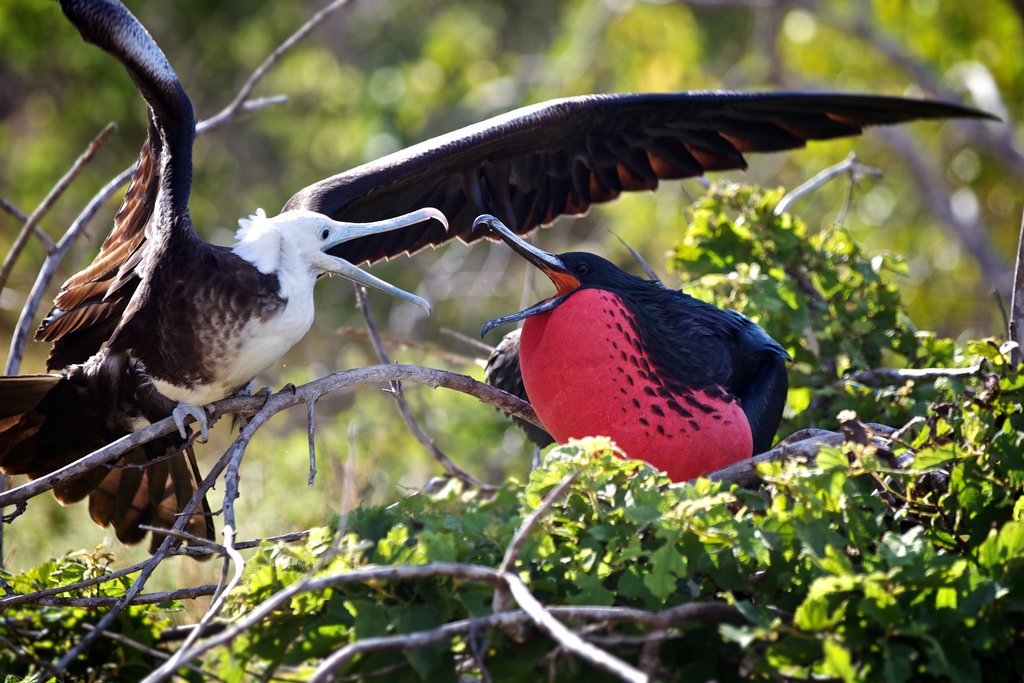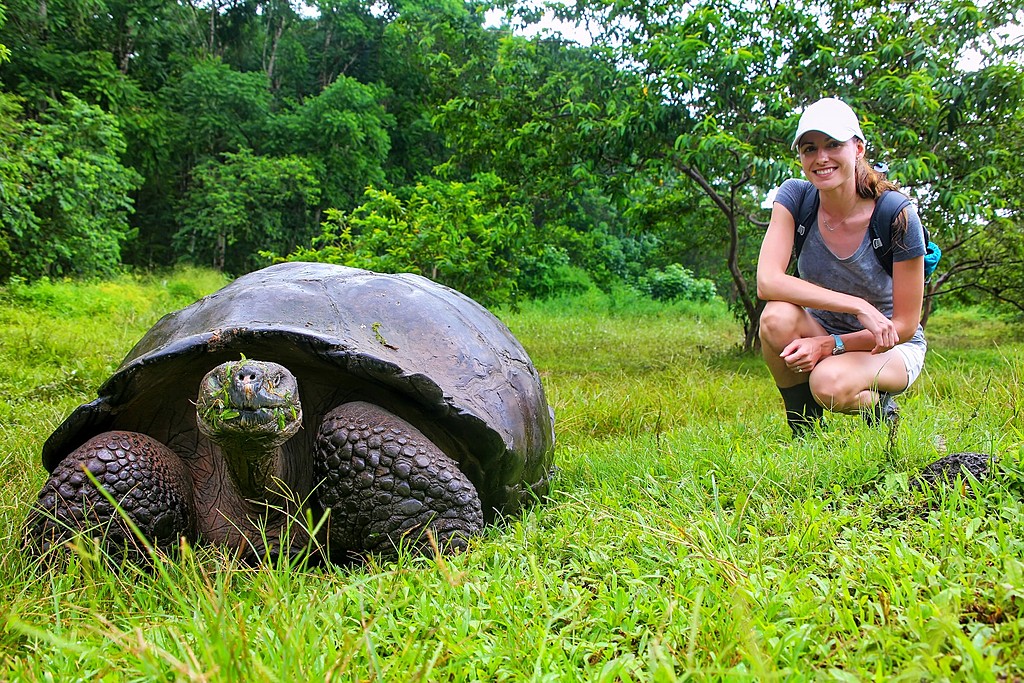Highlights
- Snorkel with playful sea lions in the Galápagos Islands
- Stroll through Quito's UNESCO-listed historic center
- Explore the biodiversity of the Galápagos
- Spot giant tortoises in the highlands of Isla Santa Cruz
- See endemic animals, such as the marine iguanas
Brief Itinerary
| Day | Highlights | Overnight |
|---|---|---|
| Day 1 | Arrive in Quito, City Tour | Quito |
| Day 2 | Hike in Cotopaxi National Park | Quito |
| Day 3 | Fly to Isla Baltra, Board Cruise to Isla Seymour Norte | Isla Seymour Norte |
| Day 4 | Isla Genovesa: Prince Phillip Steps & Darwin Bay | Isla Genovesa |
| Day 5 | Snorkeling on Isla Bartolomé & Lava Fields on Sullivan Bay | Isla Santiago |
| Day 6 | Isla Santa Cruz, Highlands Tortoises & Charles Darwin Station | Isla Santa Cruz |
| Day 7 | Isla Floreana: Cormorant Point & Post Office Bay | Isla Floreana |
| Day 8 | Isla Española: Gardner Bay & Suarez Point | Isla Española |
| Day 9 | Isla San Cristóbal: Punta Pitt & Witch Hill | Isla San Cristóbal |
| Day 10 | Isla Lobos, Transfer to San Cristóbal Airport & Depart |
Detailed Itinerary
Day 1: Arrive in Quito, City Tour

Welcome to Quito, the capital of Ecuador! Arrive at the Mariscal Sucre International Airport (UIO), where your driver will meet you to transfer to your accommodation in the city center, a one-hour trip. Along the way, you'll get a short introduction to Quito's history and a quick briefing on the next day's activities.
Ecuador's capital stands at an altitude of 9,350 feet (2,850m), and its UNESCO-listed historic center welcomes visitors with picturesque plazas situated between mountain peaks. The city has an abundance of market stands, shamanistic healers, and fourth-generation hat makers, as well as a vibrant and sophisticated culinary and nightlife scene. In the afternoon, go on a guided walking city tour of Quito's colonial center, meandering down romantic narrow streets to see the colonial churches of San Francisco, La Compañia de Jesús, and other historical landmarks.
Day 2: Hike in Cotopaxi National Park

After breakfast, transfer south into the Andean highland landscapes of Cotopaxi National Park, stopping en route at Limpiopungo Lagoon for a short hike to take in the panoramic mountain views. You'll also see the El Salitre Inca Ruins, located in the park's highlands. Keep an eye out for wildlife—Lake Limpiopungo is home to a variety of birds and occasionally even wild horses. If time permits, hike up to the refuge above Limpiopungo to enjoy the view from above, then return to Quito for the evening.
Day 3: Fly to Isla Baltra, Board Cruise to Isla Seymour Norte

In the morning, take a flight to Baltra Airport on the Galápagos Islands. Upon arrival, you'll pass through an airport inspection point to make sure that no foreign plants or animals are being introduced to the fragile island ecosystem. A guide will meet you, help you collect your luggage, and escort you on a short bus ride to the harbor.
Spend the afternoon exploring nature on Isla Seymour Norte. This island is popular with visitors, and for a good reason: it's full of wildlife, with plenty of opportunities for photographs and seeing seabirds up close. An easily-accessible walking path loops through the archipelago's most extensive colony of blue-footed boobies and frigatebirds. If you're lucky enough to visit in the breeding season, you'll witness one of the animal kingdom's most distinctive breeding displays, when male frigatebirds blow up their vivid red, football-sized pouches to impress the females.
Day 4: Isla Genovesa: Prince Phillip Steps & Darwin Bay

Start the day with a boat ride to Prince Philip Steps on Isla Genovesa. The morning's wildlife hike starts with a steep climb up some stairs to reach a flat rocky plateau. Along your walk, you'll see large colonies of Nazca boobies, red-footed boobies, great frigatebirds, and storm petrels. If you would rather stay on board the ship, keep sailing along the base of the cliffs for a different view of the nesting bird colonies.
In the afternoon, make your way to Darwin Bay, where you can spend the afternoon enjoying the ocean waves and discovering the underwater world. Following your dip, take an easy stroll to see hundreds more birds: mainly frigatebirds, red-footed and Nazca boobies, gulls, herons, finches, and mockingbirds. There will also be other opportunities for snorkeling, kayaking, and swimming.
Chat with a local specialist who can help organize your trip.
Day 5: Snorkeling on Isla Bartolomé & Lava Fields on Sullivan Bay

In the morning, make your way to Bartolomé Island, a small island with beautiful white-sand beaches, lush mangroves, and a colony of penguins. Spend the first half of the day swimming, snorkeling, and enjoying the water on a panga (inflatable boat) ride. For one of the most breathtaking views in all of the Galápagos, climb to the island's summit, and look for nearby Pinnacle Rock.
In the afternoon, continue to Sullivan Bay. It's located at the east end of Isla Santiago and is famous for its black lava field that twists and flows as though it just cooled off yesterday. As you hike around the island, pay attention to the crystallized volcanic glass along the 1.2-mile (2 km trail) that winds around the bay, and look for volcanic cones that were once rocky islets.
Day 6: Isla Santa Cruz, Highlands Tortoises & Charles Darwin Station

Today takes you to Isla Santa Cruz, where you'll head to the highlands to see giant tortoises in the wild. Enjoy lunch at a local farm, then continue to Puerto Ayora. The larges town in the archipelago is home to roughly 25,000 people and is a central hub for ecological research.
In the afternoon, visit the Charles Darwin Station, where scientists from all over the world meet and work together. Environmental projects include water analysis, protection of endemic wildlife, effects of tourism on nature, and other pressing issues. Visit the turtle rearing station to see where animals are raised before being released into nature. Keep an eye out for land iguanas, who live around the station.
Day 7: Isla Floreana: Cormorant Point & Post Office Bay

In the morning, arrive at Cormorant Point on Isla Floreana, then take an inflatable boat to shore. On arriving, you'll notice that the beach has a subtle green hue: this is due to olivine, a volcanic crystal. Your walk takes you past endemic Scalesia plants to a shallow lagoon that's often inhabited by shockingly pink greater flamingoes.
Continue through a forest of palo santo trees to arrive at a white-sand beach, a local nesting area for green turtles. Step into the shallow water to spot diamond stingrays and white-tipped reef sharks. This coral-sand beach marks the end of the trailhead back to the olivine beach to swim or snorkel. Underwater, look for sea turtles, reef fish, sea lions and, on a good day, whitetip reef sharks. A small colony of penguins calls Floreana home and can sometimes be spotted as well.
After lunch, a short walk from the beach brings you to the famous 18th-century Post Office Barrel, allegedly the oldest functioning "post office" in the Pacific. Whalers and fur sealers used the barrel to leave addressed letters in the barrel, to be picked up by homeward-bound colleagues. In the spirit of maintaining tradition, visitors today often take letters and hand-deliver them in their home countries.
Day 8: Isla Española: Gardner Bay & Suarez Point

Spend the day on Isla Española. Your first stop is Gardner Bay to see wildlife. Although Gardner Bay is an important breeding site for Pacific green turtles, its main attraction is a Galápagos sea lion colony and nursery. Females stay year-round here, suckling their pups for up to three years (even though the pups start to fish at five months). During the breeding and mating seasons, the colony grows in both size and volume.
In the afternoon head to Suarez Point, where powerful ocean waves crash onto the southern basaltic cliffs. The ceaseless water forms a spectacular blowhole, spraying water high into the air. Spend some time here exploring the coast and taking in the views before returning to the ship.
Day 9: Isla San Cristóbal: Punta Pitt & Witch Hill

You'll spend the day on San Cristóbal. In the morning head to Pitt Point, characterized by two wind-sculptured tuff cones that make up the extreme eastern end of the island (as well as the archipelago). These cliffs were the first sight of land when Charles Darwin arrived here in 1835. A group of barking Galápagos sea lions marks your arrival to the green sand beach. This is a bachelor colony, where males separate from the females to relax and prepare themselves for fighting and mating.
Hike up a trail behind the saltbush and spiny shrubs to an area of tropical dry forest. Here, you'll find palo santo trees, yellow cordia shrubs, tiny prickly pear cacti, and carpetweed that turns red in the dry season. After a somewhat steep climb through a gully to the clifftop, wander around the only bird colony in the Galápagos home to all three species of boobies: blue-footed, red-footed, and Nazca. You'll also see both species of frigatebird (great and magnificent), famous for their scarlet balloon pouches. Frigatebirds are notorious for thieving the day's catch from boobies rather than fishing for themselves.
In the afternoon, make your way to Witch Hill. The primary attraction of this site is the coral-sand beach, which is an excellent place to swim and snorkel. The hill is the remains of a tuff cone and was one of the first sites visited by Charles Darwin. Both coastal and migratory birds, including pelicans, blue-footed boobies, and swallow-tailed gulls, nest up here. Sea lions and marine iguanas are also common. During dry spells, the lagoon dries out, and deposits of salt remain on the bottom.
Day 10: Isla Lobos, Transfer to San Cristóbal Airport & Depart

In the morning, visit Isla Lobos, meaning "Sea Lion Island." This appropriately named island is home to raucous sea lions, as well as other wildlife. Go snorkeling, hiking around the island, and bird-watching before returning to Isla San Cristóbal where you'll head to the airport for your return flight to mainland Ecuador. Safe travels!
More Great Galápagos Itineraries
Looking for more inspiration for your trip to the Galápagos? Check out these other Galápagos itineraries, explore different ways to spend 10 days in the Galápagos, or discover the best time to visit the Galápagos.


